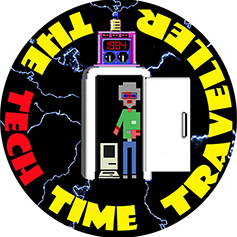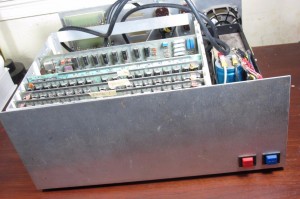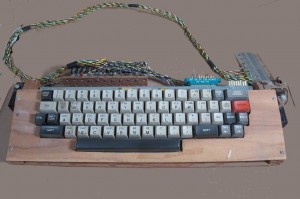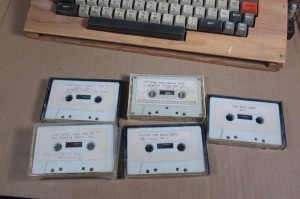I have, at last count, about 100 vintage computers in my collection. Some are just PC clones and laptops, but the majority are non-PC, things like my Apple IIs, Apple III, Lisa, SWTPC TVT2, etc.
One evening while perusing Ebay I came across this ungainly beast:
At first I thought it was a generic S100 system. I still don’t have any S100 stuff in my collection — although I am saving up feverishly for an Altair. At a $695 Buy It Now price, I would have passed it by, but then I noticed the keyboard:
You just gotta love a home re-engineered keyboard like that!
But not only that, check this out! Original tapes!!
Cool. I’ve been collecting vintage computers for years, and typically I never end up with software. Because I have to economize, I usually pick systems that are missing pieces, non-functional, etc. I like the challenge of restoring an old computer to working status, and of course, buying broken saves money up front. Which is important, when most of this stuff is coming up from the US with huge shipping charges and duty fees.
Now, I had no idea what a Digital Group Z80 was. Seeing the word ‘Digital’ in the name immediately made me think of DEC, but the two are not the same. Digital Group, it turns out, was a company founded in late 1974 by Dr. Robert Suding. Like many early computer companies, Digital Group had its own personality. Catering mostly to hobbyists, Digital Group pushed the idea that you did not have to lock yourself into a particular CPU. If you had an 8080 CPU and wanted to change to a 6800, all you had to do was change one card, instead of throwing out the entire computer. Another important feature was the ‘warm boot’. When a user turns on a Digital Group machine, they are presented with a prompt to insert an Operating System Tape, which the system reads and then sets up a menu with some basic commands. Cool! Remember, this was happening at a time when Altair users were getting finger blisters just to make lights blink!
It turned out that this Z-80 I was looking at was the very first complete computer designed around that chip. Dr. Suding designed it within 2 weeks of receiving engineering samples!
Now me, I’ve always regarded the Z-80 as sort of the Toyota Camry of processors. They’re reliable, dependable and literally everywhere. They’re still produced today, in fact! And for some reason, that’s always made the Z-80 less exciting to me. A Z-80 running CP/M is like that Camry in beige. Too… common. Which isn’t fair — a lot of great machines, like the ZX80 and ZX81 use that particular chip. I don’t know. We collectors all have our quirks, I guess.
Set against the Camry factor was this computer’s ‘firstness’, followed by the accessories included, and finally by the fact that it was inoperative. I’m really getting to enjoy fixing old machines — in fact, that’s the major part of it for me these days. I wanted to see if I could get this early beast going again. I dropped a bid, and then upped it a bit, convinced someone would snipe it. But no one did!
I got a little less excited remembering that heady days of the Canadian dollar being at par with the American greenback were over. That $695, plus shipping, would eventually come out to over $1300 in Canadian money, including duty and taxes. Ugh. But it’s not every day you get to buy something like this. As an example of the very first complete Z80 system, and considering it’s era, right in that band when the Altair and Apple I were making appearances — it was a must have. Now I just had to wait…



